Filipino interior design combines traditional and modern elements. This unique blend is characterized by the use of indigenous materials like bamboo, rattan, and capiz shells, which are expertly combined with tropical modernism and minimalist principles. For example, bamboo is often used to create sustainable and durable furniture, while rattan is used to add a touch of natural elegance to a room.
Vibrant colors and textiles are inspired by the Philippine landscape. The country's lush tropical forests, beaches, and mountains inspire the use of bright colors and bold patterns in textiles, such as batik and abaca fabric. These textiles are often used to create statement pieces, like vibrant throw pillows or colorful rugs.
Handcrafted decorative pieces reflect cultural heritage. Filipino designers often incorporate traditional crafts, such as woodcarvings, weaving, and pottery, into their designs. For instance, wooden sculptures inspired by Filipino mythology are used as decorative accents, while handwoven baskets are used as storage containers.
Eco-friendly design practices prioritize natural materials and energy efficiency. Filipino designers are committed to sustainability, using natural materials whenever possible and incorporating energy-efficient features, such as solar panels and rainwater harvesting systems, into their designs. This approach not only reduces environmental impact but also creates a healthier living space.
Incorporating Indigenous Materials
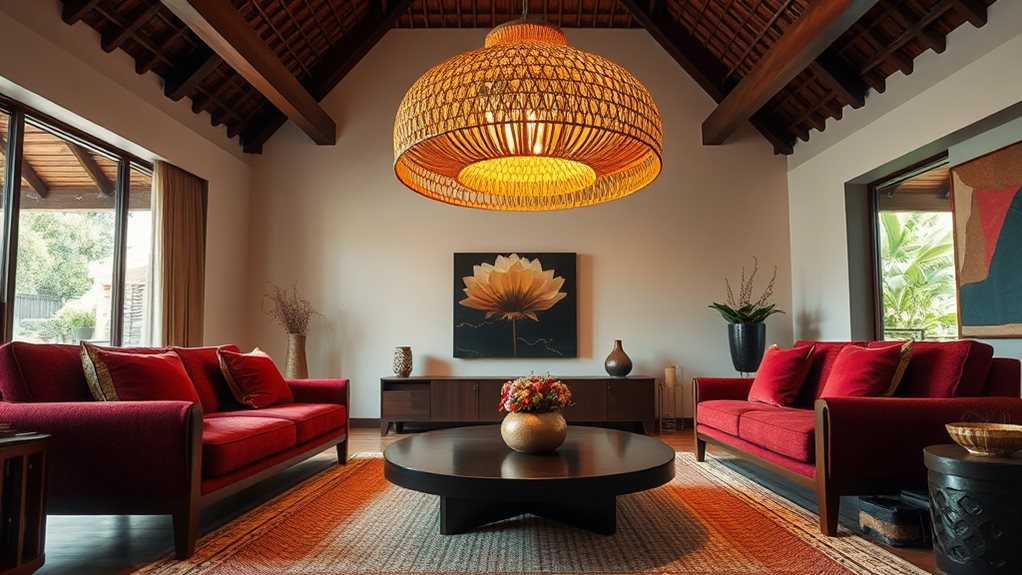
Incorporating indigenous materials is a key element in contemporary Filipino interior design. This style often features bamboo, which is used for furniture such as bed frames, sofa sets, and tables due to its versatility and durability. Bamboo adds a unique aesthetic to any room and is a popular choice for furniture.
Rattan is another popular material in Filipino interior design. Its flexibility and durability make it ideal for creating comfortable and naturally aesthetic furniture pieces. Rattan is often used for chairs, tables, and other decorative items.
Abaca, a sustainable material, is commonly used for furniture that evokes an exotic island feel. Its durability and eco-friendliness make it a popular choice for interior designers.
Decorative elements often feature Capiz shells, which are used to create unique lampshades, chandeliers, and wall art. The shells add a distinctive and ethereal glow to any room.
Sustainable building materials are also used, such as coconut shell laminates like Cocoboard. These materials provide an eco-friendly alternative to traditional building materials and help reduce waste.
Tropical Modernism Design Principles
Tropical Modernism prioritizes climatic responsiveness by incorporating natural elements to reduce reliance on artificial cooling. This is achieved through cross-ventilation strategies, such as large windows and strategically placed openings, which maximize airflow and natural light.
Natural shading techniques, like extended overhangs and pergolas, also help maintain indoor comfort.
To integrate space with nature, blur the boundaries between indoor and outdoor areas by incorporating open spaces, verandas, and courtyards.
Landscaping elements like lush gardens and water features enhance natural ventilation and openness.
Strategic placement of openings and large windows optimizes the use of natural light and ventilation.
Adaptive Reuse in Interior Design
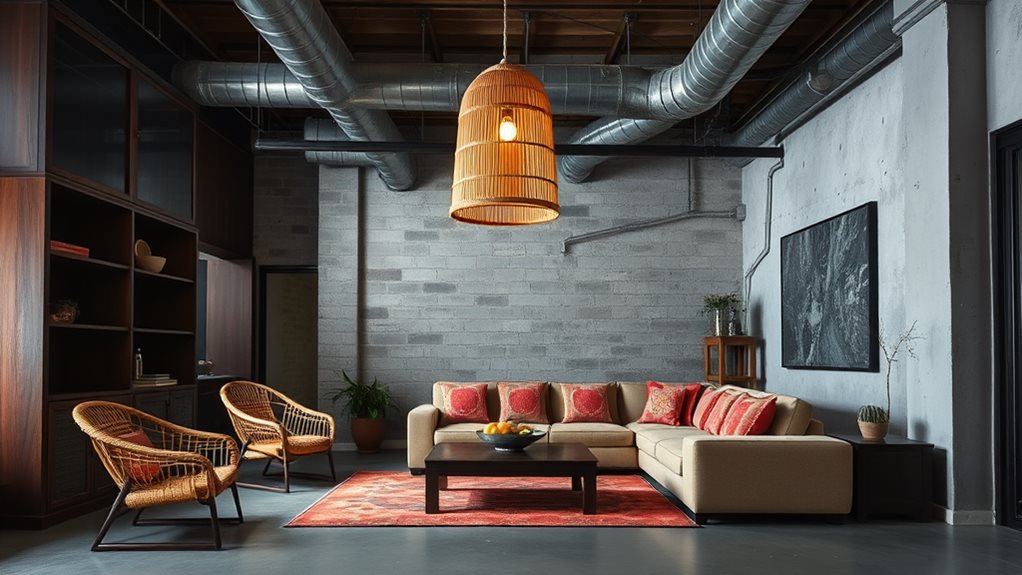
Adaptive Reuse in Interior Design: Preserving Heritage and Functionality
Adaptive reuse is an interior design approach that revitalizes historical structures by preserving their essence while incorporating modern functionality.
In the Philippines, this approach is crucial for maintaining cultural identity through historical preservation.
The process involves thorough documentation and assessment to recognize the structure's contributions to the community, thereby maintaining the cultural and historical identity of the space. This ensures that heritage houses and historic structures are repurposed rather than demolished, allowing continued use and relevance.
Integrating Traditional and Modern Elements
In adaptive reuse, traditional and modern elements are combined to create a unique design.
Old materials are repurposed into new design elements, blending traditional craftsmanship with modern aesthetics and functionalities. For instance, wooden beams from an old house might be reused as decorative ceiling features or wall accents. This fusion ensures the structure remains relevant and functional in the present day.
Promoting Community Engagement and Cultural Heritage
Adaptive reuse strengthens the connection to the past and enhances community spirit by transforming old buildings into community-centric spaces.
This approach promotes community engagement and reflects community values and cultural heritage. By doing so, it preserves the cultural identity of the community and fosters a sense of belonging.
Minimalist Filipino Design Elements
Minimalist Filipino design elements emphasize functional aesthetics and simplicity. This style is characterized by clean lines, minimal ornamentation, and the use of natural materials.
Rattan, bamboo, and wood are commonly used, often paired with synthetic materials to ensure durability and modern functionality.
The color palette is predominantly neutral, featuring shades of white, beige, and warm browns that evoke the earthy tones of the Philippine landscape. This palette, combined with ample lighting, creates a sense of spatial harmony and airiness.
Furniture is designed with clean lines and minimal ornamentation, often made from woven materials.
Large windows and open floor plans maximize natural light and ventilation, resulting in a clean, airy, and modern space that exudes simplicity and elegance.
Vibrant Colors and Textiles
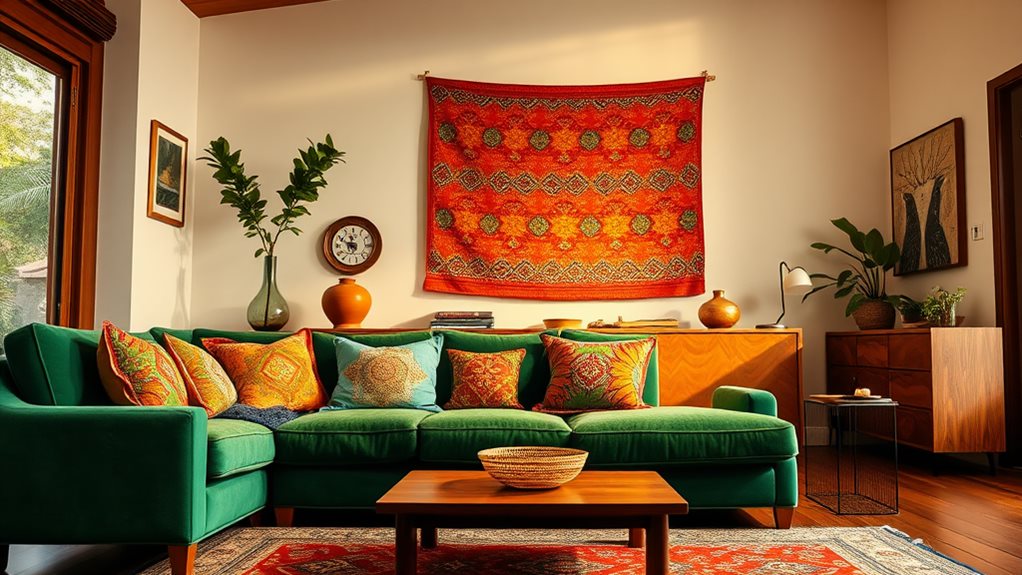
Incorporating vibrant colors and textiles is a key element in Filipino interior design. This approach adds personality to a space while paying tribute to the country's rich cultural heritage.
Earthy and vibrant color schemes inspired by the Philippine landscape, featuring shades of brown, green, and blue, can be used to infuse a space with warmth and vitality. Rust and burnt orange accents can add a pop of color and energy.
Traditional motifs can be blended with modern elements to create a unique design. Textile layering is essential, and indigenous materials like rattan, buri, and abaca can be used in hand-woven textiles.
Traditional carpet patterns and textiles can add visual interest and texture to modern spaces. Handcrafted accents, including woven baskets and intricately carved wooden furniture, can add character to a room.
Color psychology plays a crucial role in choosing colors to evoke a desired mood and atmosphere. When selecting colors, consider the emotions and feelings you want to evoke in your space.
Sustainable Design Solutions
Sustainable design solutions are essential in contemporary Filipino interior design because they reduce environmental impact while paying homage to the country's rich cultural heritage.
Using natural materials sourced sustainably, such as rattan, bamboo, and distinct Filipino wood species, adds warmth and texture to a space. These materials can be combined with high-quality synthetic options to achieve durability and versatility while reducing waste.
Biophilic design is a key aspect of sustainable design solutions, as it brings the outdoors in, creating a seamless transition between nature and interior spaces. This design approach also promotes a connection to the natural environment, which is essential for a healthy and sustainable lifestyle.
Handcrafted and artisanal accents can add a touch of local culture to a space, making it unique and authentic. By incorporating these elements, individuals can contribute to a more environmentally conscious community and support local artisans.
Embracing sustainable design solutions has numerous benefits, including reducing waste, promoting durability, and supporting local culture.
Filipino Cultural Heritage Inspiration
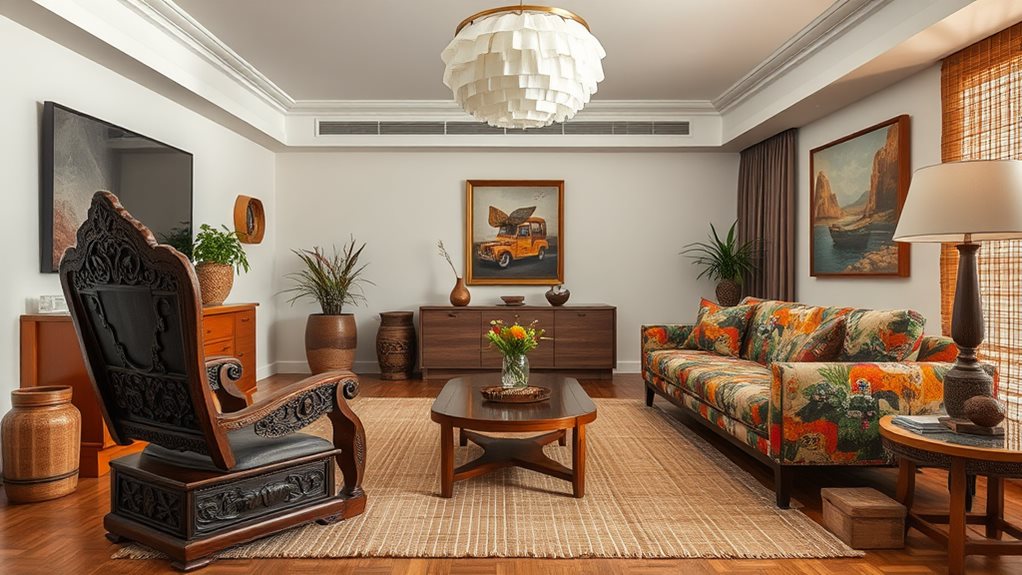
Cultural heritage significantly influences contemporary Filipino interior design. Traditional patterns and motifs are incorporated into modern furniture and textiles, adding a touch of cultural storytelling to any space.
For instance, indigenous weaving techniques are used to create unique furniture pieces and decor, blending historical and contemporary elements.
Cultural icons and symbols are thoughtfully integrated into modern designs. Capiz shells and handwoven baskets are used to add an air of authenticity to spaces.
Historical design elements, such as stamped patterns on walls and ceilings, are reimagined in contemporary spaces.
The *Bahay Kubo*, a traditional Filipino hut, inspires modern lounging areas designed for comfort and natural ventilation.
Natural Materials in Furniture
Natural materials bring warmth and authenticity to Filipino interior design. Rattan, a hallmark of Filipino design, is a popular choice for furniture pieces like chairs, sofas, and coffee tables because it adds texture and warmth to living spaces.
Its versatility also makes it suitable for both indoor and outdoor use.
Bamboo is a sustainable and strong material. It's prized for its eco-friendliness and strength, making it ideal for various furniture pieces and decorative elements.
Bamboo adds a natural and earthy feel to the living space, and when combined with other materials, it creates a blend of traditional and modern aesthetics.
Wood, particularly hardwood, is a staple in Filipino furniture design. It adds warmth and authenticity to any room.
The incorporation of natural materials like capiz shells, natural stones, and pebbles creates a harmonious connection with the environment and the country's natural beauty.
Handcrafted Decorative Pieces
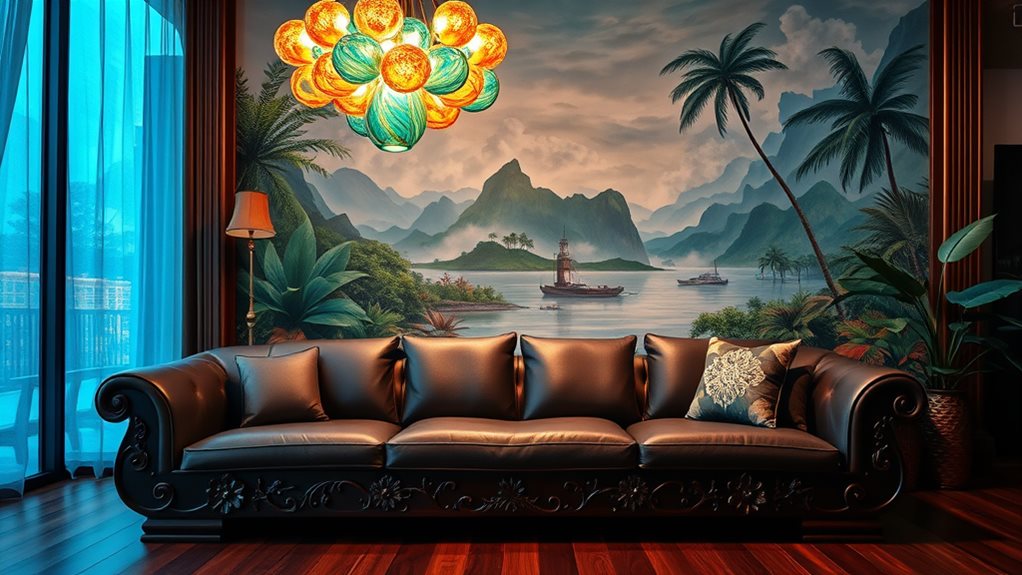
Handcrafted decorative pieces are essential in Filipino interior design, as they infuse spaces with cultural significance and artisanal flair. Traditional motifs and patterns are often incorporated into modern interior design, adorning furniture, textiles, and décor.
For instance, handwoven baskets and intricately carved wooden furniture add character and authenticity to a space. Artisans use indigenous materials like rattan, bamboo, and Capiz to create these accents, blending traditional craftsmanship with modern design sensibilities.
Filipino ethnic and tribal art influences handcrafted décor, reflecting colonial and Asian influences. Wooden statuettes, Jesu Hands, and candelabras painted with alibata letters are examples of decorative symbolism.
These decorative pieces can also incorporate historical elements, such as items from vintage thrift shops. By using traditional materials and designs in modern settings, cultural heritage is celebrated, contributing to a unique and culturally rich interior design style.
Incorporating handcrafted decorative pieces infuses a space with artisanal craftsmanship and cultural significance.
Urban Tropical Interior Spaces
By embracing Tropical Modernism, you can transform your urban space into a serene oasis that combines indoor comfort with outdoor freshness.
Natural Ventilation is key to achieving this look. Large windows and open floor plans allow natural light and ventilation to flow freely, connecting your indoor space to the outdoors.
For example, sliding glass doors can replace traditional walls, creating a seamless transition between indoors and outdoors.
Earthy Accents are essential in evoking a tropical landscape. Incorporate natural materials like rattan, bamboo, and stone to bring the outdoors in.
Adding lush greenery, such as potted plants or a living wall, can also enhance the tropical feel.
Airy Spaces are critical in creating a tranquil escape. Emphasize open and inviting areas that blur the lines between indoors and outdoors.
For instance, a spacious living room with minimal partitions can create a sense of freedom and relaxation.
Organic Colors can create a calming atmosphere reminiscent of the tropical outdoors. Use earthy tones like beige, brown, and green, and incorporate natural fibers like jute and sisal to create a soothing ambiance.
Eco-Friendly Design Practices
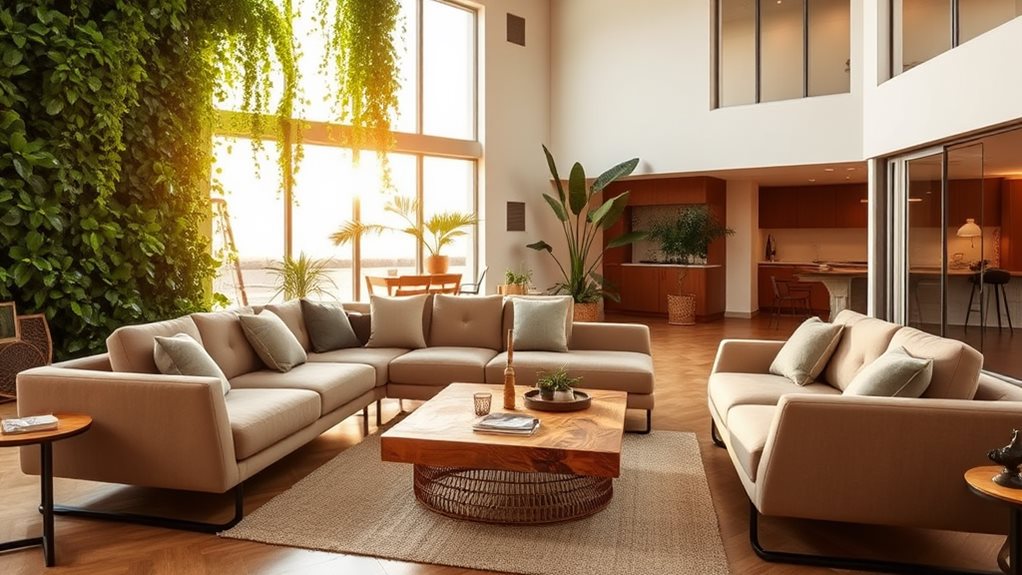
Eco-friendly design practices prioritize sustainable sourcing and energy efficiency to reduce environmental impact.
Filipino interior designers opt for natural and indigenous materials like rattan, bamboo, capiz, and hardwood. These materials add texture, warmth, and authenticity to a space while reducing the carbon footprint. For instance, using bamboo instead of steel can reduce carbon emissions by up to 70%.
Energy efficiency is a key consideration in eco-friendly design. Designers incorporate open and airy spaces, natural ventilation, and light colors to maximize natural light and reduce the need for artificial lighting. This approach not only reduces energy consumption but also creates a brighter and more welcoming atmosphere.
Eco-friendly design practices also involve the use of sustainable products. Designers incorporate eco-friendly products like synthetic materials with natural appeal, recycled furniture, and multi-functional pieces to minimize waste and reduce energy consumption.
For example, using recycled glass as a decorative element can reduce waste and add a unique touch to a space.
By adopting eco-friendly design practices, you can create a space that isn't only beautiful but also sustainable and responsible.
Questions and Answers
What Is the Average Cost of Incorporating Indigenous Materials Into a Design?
The cost of incorporating indigenous materials into a design can vary greatly, depending on factors such as sourcing and labor intensity.
Incorporating indigenous materials can be cost-effective if sourced locally, reducing transportation costs. For example, using reclaimed wood from local forests can be more affordable than importing materials from other regions. However, labor intensity and research requirements may drive up costs. Conducting thorough research to identify suitable materials and ensuring compliance with regulations can be time-consuming and expensive.
Long-term benefits of sustainable practices can offset initial expenses.
While incorporating indigenous materials may require significant upfront investment, sustainable practices can lead to cost savings in the long run. For instance, using natural, locally sourced materials can reduce the need for maintenance and replacement, resulting in lower costs over time.
How Do I Balance Modernity With Cultural Heritage in My Interior Design?
Balancing Modernity with Cultural Heritage
Incorporating Cultural Symbolism
To balance modernity with cultural heritage, start by incorporating cultural symbolism into your design inspiration. This means drawing from your cultural background and selecting elements that hold significance. For instance, if you're designing a space for an Indian family, you might incorporate the lotus flower, a symbol of spiritual growth and enlightenment, into your design.
Blending Traditional Elements with Modern Aesthetics
Next, blend traditional elements with modern aesthetics. This can be achieved by pairing classic cultural pieces, such as vintage textiles or antique furniture, with modern materials and designs. For example, you could pair a traditional African kente cloth with a sleek, minimalist couch.
Thoughtfully Selecting Materials
Finally, thoughtfully select materials that honor the past while serving the present. This might involve using sustainable materials, repurposing vintage items, or incorporating natural elements that reflect your cultural heritage. For instance, you could use reclaimed wood from an old Japanese temple to create a modern dining table.
Can I Mix and Match Different Filipino Design Styles in One Space?
Yes, you can mix and match different Filipino design styles in one space. Combining cultural motifs with modern elements can create design harmony and ensure space functionality. For instance, incorporating traditional Filipino textiles, such as T'nalak or Inabel, into modern furniture pieces or decor can add a touch of cultural heritage to the space. This fusion of old and new elements can result in a unique and visually appealing design that honors Filipino culture while still meeting modern needs.
Are There Any Specific Certifications for Sustainable Design in the Philippines?
Yes, there are certifications for sustainable design in the Philippines. These certifications, such as BERDE, LEED, and EDGE, promote sustainable architecture and the use of eco-friendly materials, ensuring a reduced environmental footprint. For instance, BERDE (Building for Ecologically Responsive Design Excellence) is a Philippine-based certification program that evaluates buildings based on their environmental performance. LEED (Leadership in Energy and Environmental Design) is a global certification program that recognizes buildings that have achieved a high level of sustainability. EDGE (Excellence in Design for Greater Efficiencies) is another certification program that focuses on resource efficiency in buildings.
How Often Should I Replace or Update My Interior Design to Stay Trendy?
To stay trendy, update your interior design every 5-10 years. This timeframe allows you to keep up with changing design trends while considering the average lifespan of furniture, which can range from 5 to 15 years depending on quality and usage. Make seasonal tweaks to keep your space fresh, such as swapping throw pillows, rugs, or wall art, which can be done more frequently without breaking the bank. Balance budget constraints and lifestyle changes by prioritizing updates based on your needs and financial situation. For example, if you have a growing family, you may need to update your furniture more frequently to accommodate changing needs.